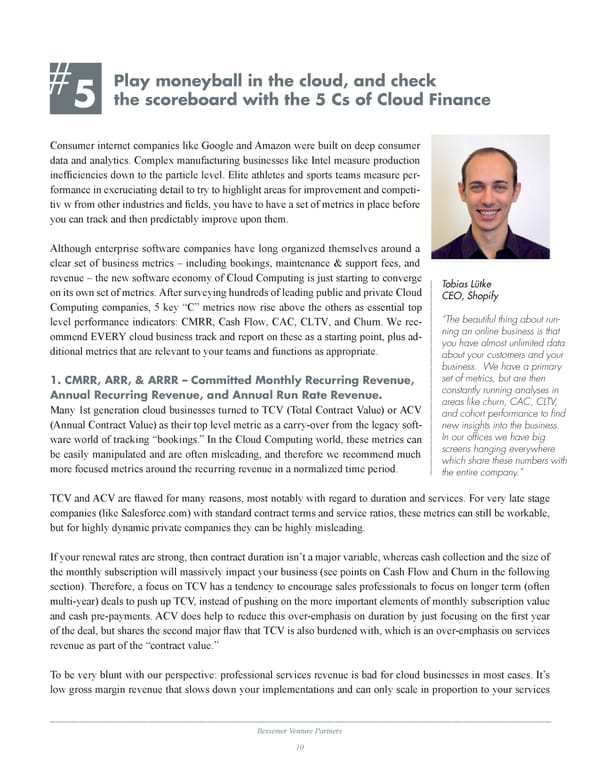# Play moneyball in the cloud, and check 5 the scoreboard with the 5 Cs of Cloud Finance Consumer internet companies like Google and Amazon were built on deep consumer data and analytics. Complex manufacturing businesses like Intel measure production inefficiencies down to the particle level. Elite athletes and sports teams measure per- formance in excruciating detail to try to highlight areas for improvement and competi- tiv w from other industries and fields, you have to have a set of metrics in place before you can track and then predictably improve upon them. Although enterprise software companies have long organized themselves around a clear set of business metrics – including bookings, maintenance & support fees, and revenue – the new software economy of Cloud Computing is just starting to converge Tobias Lütke on its own set of metrics. After surveying hundreds of leading public and private Cloud CEO, Shopify Computing companies, 5 key “C” metrics now rise above the others as essential top level performance indicators: CMRR, Cash Flow, CAC, CLTV, and Churn. We rec- “The beautiful thing about run- ommend EVERY cloud business track and report on these as a starting point, plus ad- ning an online business is that ditional metrics that are relevant to your teams and functions as appropriate. you have almost unlimited data about your customers and your business. We have a primary 1. CMRR, ARR, & ARRR – Committed Monthly Recurring Revenue, set of metrics, but are then Annual Recurring Revenue, and Annual Run Rate Revenue. constantly running analyses in Many 1st generation cloud businesses turned to TCV (Total Contract Value) or ACV areas like churn, CAC, CLTV, and cohort performance to find (Annual Contract Value) as their top level metric as a carry-over from the legacy soft- new insights into the business. ware world of tracking “bookings.” In the Cloud Computing world, these metrics can In our offices we have big be easily manipulated and are often misleading, and therefore we recommend much screens hanging everywhere more focused metrics around the recurring revenue in a normalized time period. which share these numbers with the entire company.” TCV and ACV are flawed for many reasons, most notably with regard to duration and services. For very late stage companies (like Salesforce.com) with standard contract terms and service ratios, these metrics can still be workable, but for highly dynamic private companies they can be highly misleading. If your renewal rates are strong, then contract duration isn’t a major variable, whereas cash collection and the size of the monthly subscription will massively impact your business (see points on Cash Flow and Churn in the following section). Therefore, a focus on TCV has a tendency to encourage sales professionals to focus on longer term (often multi-year) deals to push up TCV, instead of pushing on the more important elements of monthly subscription value and cash pre-payments. ACV does help to reduce this over-emphasis on duration by just focusing on the first year of the deal, but shares the second major flaw that TCV is also burdened with, which is an over-emphasis on services revenue as part of the “contract value.” To be very blunt with our perspective: professional services revenue is bad for cloud businesses in most cases. It’s low gross margin revenue that slows down your implementations and can only scale in proportion to your services Bessemer Venture Partners 10
 Bessemer’s Top 10 Laws of Cloud Computing Page 9 Page 11
Bessemer’s Top 10 Laws of Cloud Computing Page 9 Page 11